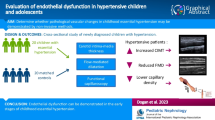Abstract
Background
Children with nephrotic syndrome (NS) have hyperlipidemia, which may lead to endothelial dysfunction. This study evaluated endothelial function and structural atherosclerosis in NS children with disease duration more than 2 years, by assessment of brachial artery flow-mediated dilatation (FMD) and carotid intima medial thickness (CIMT).
Methods
This is a cross-sectional case–control study recruiting 32 subjects aged 1–13 years with NS and 32 matched controls. Clinical details, FMD and CIMT were recorded. Lipid profile and oxidative stress were also analyzed in the subjects.
Results
The proportionate change in FMD was significantly lower in cases (5.65 ± 6.08 %) compared to controls (15.21 ± 9.41 %) (p < 0.01). No significant differences in CIMT were observed (p = 0.383). Blood malondialdehyde was significantly higher (p = 0.006) in the cases. Overall, 25 NS children (78 %) were in remission for more than 6 months, and in them, 9 (36 %) had deranged lipid profile. On stepwise linear regression, age of the patient was found to be a determinant of FMD (model R 2 = 18.9 %, p value = 0.048).
Conclusion
The significantly low proportionate change in FMD in NS children suggests an ongoing process of endothelial dysfunction. Further studies are needed to confirm these findings. A long-term follow-up of children with NS may be required for identification of CIMT derangements.


Similar content being viewed by others
References
Mérouani A, Lévy E, Mongeau J-G, Robitaille P, Lambert M, Delvin EE. Hyperlipidemic profiles during remission in childhood idiopathic nephrotic syndrome. Clin Biochem. 2003;36:571–4.
Zilleruelo G, Hsia SL, Freundlich M, Gorman HM, Strauss J. Persistence of serum lipid abnormalities in children with idiopathic nephrotic syndrome. J Pediatr. 1984;104:61–4.
Kniazewska MH, Obuchowicz AK, Wielkoszyński T, Zmudzińska-Kitczak J, Urban K, Marek M, et al. Atherosclerosis risk factors in young patients formerly treated for idiopathic nephrotic syndrome. Pediatr Nephrol. 2009;24:549–54.
Celermajer DS, Sorensen KE, Gooch VM, Spiegelhalter DJ, Miller OI, Sullivan ID, et al. Non-invasive detection of endothelial dysfunction in children and adults at risk of atherosclerosis. Lancet. 1992;340:1111–5.
Spence JD. Technology Insight: ultrasound measurement of carotid plaque—patient management, genetic research, and therapy evaluation. Nat Clin Pract Neurol. 2006;2:611–9.
Sutter JD, Bacquer DD, Kotseva K, Sans S, Pyörälä K, Wood D, et al. Screening of family members of patients with premature coronary heart disease results from the EUROASPIRE II family survey. Eur Heart J. 2003;24:249–57.
Ceriotti F, Boyd JC, Klein G, Henny J, Queraltó J, Kairisto V, et al. Reference intervals for serum creatinine concentrations: assessment of available data for global application. Clin Chem. 2008;54:559–66.
National High Blood Pressure Education Program Working Group on High Blood Pressure in Children and Adolescents. The fourth report on the diagnosis, evaluation, and treatment of high blood pressure in children and adolescents. Pediatrics. 2004;114:555–76.
The primary nephrotic syndrome in children. Identification of patients with minimal change nephrotic syndrome from initial response to prednisone. A report of the International Study of Kidney Disease in Children. J Pediatr. 1981;98:561–4.
Bagga A. Revised guidelines for management of steroid-sensitive nephrotic syndrome. Indian J Nephrol. 2008;18:31–9.
Allain CC, Poon LS, Chan CS, Richmond W, Fu PC. Enzymatic determination of total serum cholesterol. Clin Chem. 1974;20:470–5.
Williams P, Robinson D, Bailey A. High-density lipoprotein and coronary risk factors in normal men. Lancet. 1979;1:72–5.
Friedewald WT, Levy RI, Fredrickson DS. Estimation of the concentration of low-density lipoprotein cholesterol in plasma, without use of the preparative ultracentrifuge. Clin Chem. 1972;18:499–502.
Yagi K. Simple assay for the level of total lipid peroxides in serum or plasma. Methods Mol Biol Clifton NJ. 1998;108:101–6.
Halliwell B. Oxidative stress, nutrition and health. Experimental strategies for optimization of nutritional antioxidant intake in humans. Free Radic Res. 1996;25:57–74.
Corretti MC, Anderson TJ, Benjamin EJ, Celermajer D, Charbonneau F, Creager MA, et al. Guidelines for the ultrasound assessment of endothelial-dependent flow-mediated vasodilation of the brachial artery: a report of the International Brachial Artery Reactivity Task Force. J Am Coll Cardiol. 2002;39:257–65.
Sitzer M, Markus HS, Mendall MA, Liehr R, Knorr U, Steinmetz H. C-reactive protein and carotid intimal medial thickness in a community population. J Cardiovasc Risk. 2002;9:97–103.
Caraba A, Romoşan I. Endothelial dysfunction in the nephrotic syndrome. Med Pregl. 2007;60(Suppl 2):66–9.
Stary HC, Chandler AB, Glagov S, Guyton JR, Insull W Jr, Rosenfeld ME, et al. A definition of initial, fatty streak, and intermediate lesions of atherosclerosis. A report from the Committee on Vascular Lesions of the Council on Arteriosclerosis, American Heart Association. Circulation. 1994;89:2462–78.
Neunteufl T, Heher S, Katzenschlager R, Wölfl G, Kostner K, Maurer G, et al. Late prognostic value of flow-mediated dilation in the brachial artery of patients with chest pain. Am J Cardiol. 2000;86:207–10.
Suwaidi JA, Hamasaki S, Higano ST, Nishimura RA, Holmes DR Jr, Lerman A. Long-term follow-up of patients with mild coronary artery disease and endothelial dysfunction. Circulation. 2000;101:948–54.
Pełkowska A, Sancewicz-Pach K. Determination of endothelial function in children with nephrotic syndrome in various states of disease. Wiad Lek. 2005;58(Suppl 1):35–8.
Dogra GK, Herrmann S, Irish AB, Thomas MAB, Watts GF. Insulin resistance, dyslipidaemia, inflammation and endothelial function in nephrotic syndrome. Nephrol Dial Transplant. 2002;17:2220–5.
Watts GF, Herrmann S, Dogra GK, Playford DA, Best JD, Thomas MAB, et al. Vascular function of the peripheral circulation in patients with nephrosis. Kidney Int. 2001;60:182–9.
Wilson AC, Urbina E, Witt SA, Glascock BJ, Kimball TR, Mitsnefes M. Flow-mediated vasodilatation of the brachial artery in children with chronic kidney disease. Pediatr Nephrol. 2008;23:1297–302.
Leeson CP, Whincup PH, Cook DG, Donald AE, Papacosta O, Lucas A, Deanfield JE. Flow-mediated dilation in 9- to 11-year-old children: the influence of intrauterine and childhood factors. Circulation. 1997;96:2233–8.
Salonen JT, Salonen R. Ultrasonographically assessed carotid morphology and the risk of coronary heart disease. Arterioscler Thromb. 1991;11:1245–9.
Bots ML, Hoes AW, Koudstaal PJ, Hofman A, Grobbee DE. Common carotid intima-media thickness and risk of stroke and myocardial infarction: the Rotterdam study. Circulation. 1997;96:1432–7.
Suys B, de Beeck LOP, Rooman R, Kransfeld S, Heuten H, Goovaerts I, et al. Impact of oxidative stress on the endothelial dysfunction of children and adolescents with type 1 diabetes mellitus: protection by superoxide dismutase? Pediatr Res. 2007;62:456–61.
Pritchard KA Jr, Groszek L, Smalley DM, Sessa WC, Wu M, Villalon P, et al. Native low-density lipoprotein increases endothelial cell nitric oxide synthase generation of superoxide anion. Circ Res. 1995;77:510–8.
Lima DS, Sato EI, Lima VC, Miranda F Jr, Hatta FH. Brachial endothelial function is impaired in patients with systemic lupus erythematosus. J Rheumatol. 2002;29:292–7.
Hafström I, Rohani M, Deneberg S, Wörnert M, Jogestrand T, Frostegård J. Effects of low-dose prednisolone on endothelial function, atherosclerosis, and traditional risk factors for atherosclerosis in patients with rheumatoid arthritis—a randomized study. J Rheumatol. 2007;34:1810–6.
Acknowledgments
The study was supported by an intramural funding from the authors’ institution, which is gratefully acknowledged.
Conflict of interest
None stated.
Author information
Authors and Affiliations
Corresponding author
About this article
Cite this article
Rahul, I., Krishnamurthy, S., Satheesh, S. et al. Brachial artery flow-mediated dilatation and carotid intima medial thickness in pediatric nephrotic syndrome: a cross-sectional case–control study. Clin Exp Nephrol 19, 125–132 (2015). https://doi.org/10.1007/s10157-014-0958-1
Received:
Accepted:
Published:
Issue Date:
DOI: https://doi.org/10.1007/s10157-014-0958-1




